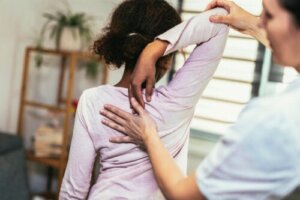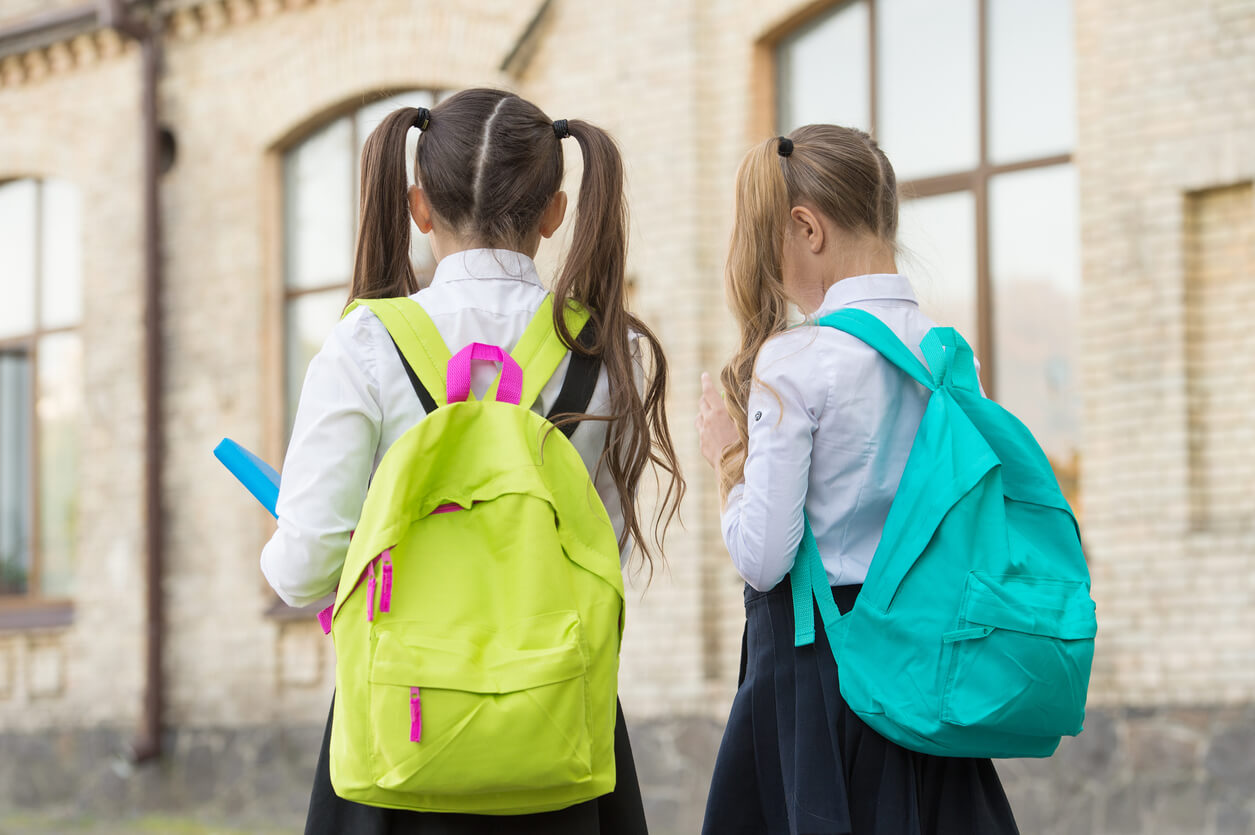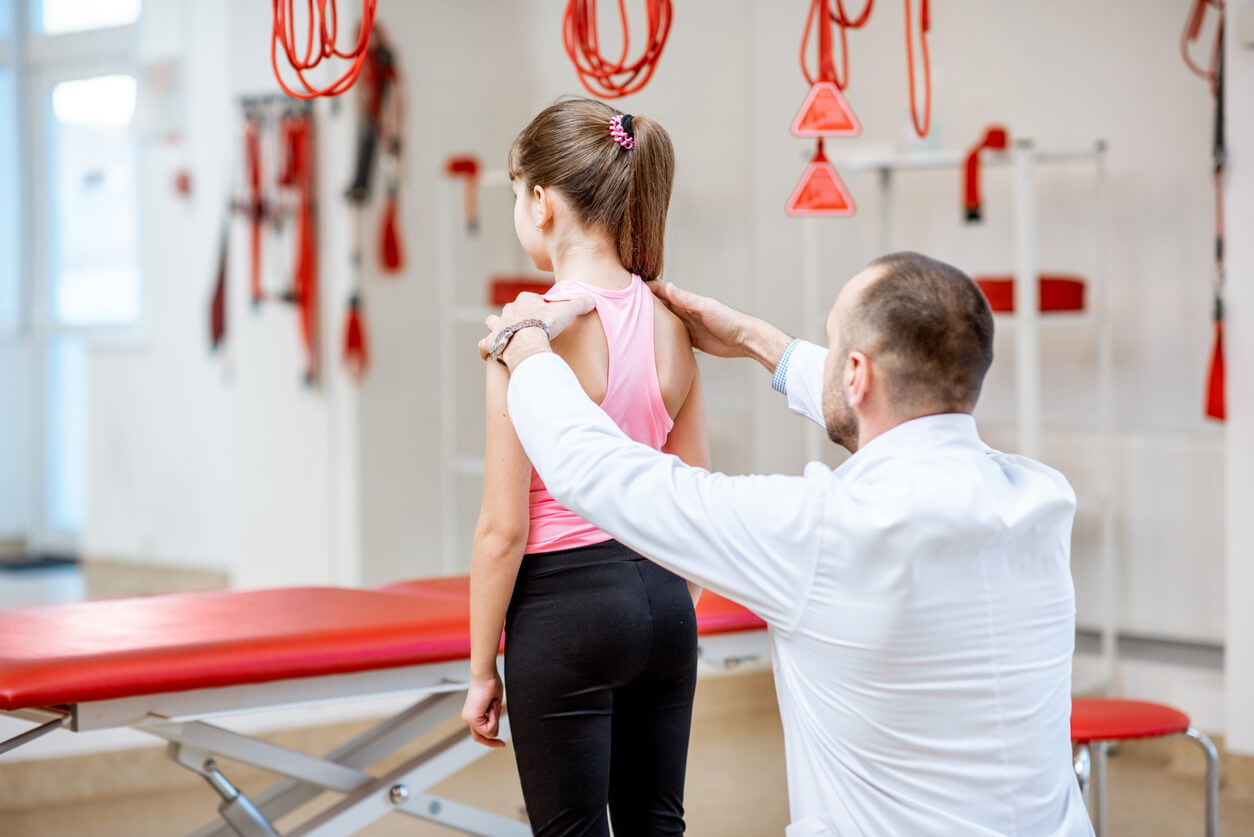Back Pain in Children and Adolescents: Symptoms, Causes, and Treatment


Written and verified by the physiotherapist Maria Elisa Lisotti Luppi
Back pain in children and adolescents is relatively frequent, as well as its referral to physical therapy. It’s common for children to feel momentary pain at some point in their developmental stage. Many times, it disappears spontaneously, but some cases require professional treatment.
In the presence of this type of pain in your child, the first step is to consult a doctor to determine the cause. Sometimes it’s necessary to perform complementary studies, such as X-rays or magnetic resonance imaging to make an accurate diagnosis.
Symptoms of back pain in children and adolescents
Pain is a symptom in itself and can present itself in different ways. For example, it can be localized in a certain point or generalized in an area of the back. In addition, there are permanent pains and others that are sporadic. Sometimes they’re even perceived at rest or at the beginning of a certain movement. Acute and chronic pain may also occur.
Back pain is less frequent up to the age of 10. However, the statistics increase notably around the age of 14. According to the cause, the location of the pain will be cervical, dorsal, sacral, or lumbar. Moreover, in some cases, it’s present in more than one area.
Currently, due to the increased use of screens, the incidence of neck pain in adolescents is becoming more frequent. This is due to poor posture sustained for long periods during the day.

Possible causes
Of all the symptoms, pain is the most common. In fact, it’s one of the main reasons for consultation in general. However, it’s also associated with other signs and symptoms that help determine the specific diagnosis. Here are some of the possible causes of back pain in children and adolescents:
- Pain associated with schooling: For example, due to the use of backpacks with an excessive weight load. School materials carried on the back shouldn’t exceed 10% of the child’s weight. Also, poor posture during the time they’re sitting on school furniture causes pain.
- Sedentary lifestyle: The lack of physical activity as a habit generates less general mobility, as well as greater weakness in the developing muscles.
- Trauma or sports injuries: These can occur during sports activities or due to falls or blows. Very demanding workouts aren’t recommended for children due to the risk of injury.
- Scoliosis: The alteration in the alignment of the spine triggers an imbalance in the activity of the back muscles. Pain in one of the areas of the spine is one of the symptoms of scoliosis.
- Scheuermann’s disease: Affects the middle or upper middle back. Therefore, it causes changes in the vertebrae and generates an increase in the curve that increases progressively.
- Infectious or tumor processes: Pain is one of the symptoms that organic conditions affecting the child can cause.
- Herniated disc: It’s very rare in adolescents and even less frequent in children.
Physical therapy treatment in children and adolescents
The procedure will first be indicated by the pediatrician. In the most severe cases, there’s the possibility of surgical treatment to correct the cause. In most of the milder cases, child physical therapy is one of the main therapeutic tools. After medical referral, the physical therapist performs a complete physical examination to determine the appropriate treatment for each child.
In children and adolescents with back pain resulting from schooling or sedentary lifestyles, physical therapy will include active mobility exercises and stretching. In addition, parents or family members are taught certain guidelines to help protect good posture for activities of daily living.
In cases of trauma, sports injuries, injuries, or scoliosis, physical therapy treatments are designed to take into account several factors. These include age, cause, and mechanism of injury. Sometimes the treatment is complemented with bandages or orthoses, such as a corset in the case of moderate to severe scoliosis.

Healthy habits, the best way to prevent
The best way to prevent back pain in children and adolescents is through healthy habits. For example, through a good quality diet and recreational physical activity. Sports at an early age should be done without overtraining and with all the safety measures to avoid injuries.
Another preventive measure is the teaching of postural hygiene. In this way, sustained positions or activities that may generate or increase this type of pain are avoided.
Back pain in children and adolescents is relatively frequent, as well as its referral to physical therapy. It’s common for children to feel momentary pain at some point in their developmental stage. Many times, it disappears spontaneously, but some cases require professional treatment.
In the presence of this type of pain in your child, the first step is to consult a doctor to determine the cause. Sometimes it’s necessary to perform complementary studies, such as X-rays or magnetic resonance imaging to make an accurate diagnosis.
Symptoms of back pain in children and adolescents
Pain is a symptom in itself and can present itself in different ways. For example, it can be localized in a certain point or generalized in an area of the back. In addition, there are permanent pains and others that are sporadic. Sometimes they’re even perceived at rest or at the beginning of a certain movement. Acute and chronic pain may also occur.
Back pain is less frequent up to the age of 10. However, the statistics increase notably around the age of 14. According to the cause, the location of the pain will be cervical, dorsal, sacral, or lumbar. Moreover, in some cases, it’s present in more than one area.
Currently, due to the increased use of screens, the incidence of neck pain in adolescents is becoming more frequent. This is due to poor posture sustained for long periods during the day.

Possible causes
Of all the symptoms, pain is the most common. In fact, it’s one of the main reasons for consultation in general. However, it’s also associated with other signs and symptoms that help determine the specific diagnosis. Here are some of the possible causes of back pain in children and adolescents:
- Pain associated with schooling: For example, due to the use of backpacks with an excessive weight load. School materials carried on the back shouldn’t exceed 10% of the child’s weight. Also, poor posture during the time they’re sitting on school furniture causes pain.
- Sedentary lifestyle: The lack of physical activity as a habit generates less general mobility, as well as greater weakness in the developing muscles.
- Trauma or sports injuries: These can occur during sports activities or due to falls or blows. Very demanding workouts aren’t recommended for children due to the risk of injury.
- Scoliosis: The alteration in the alignment of the spine triggers an imbalance in the activity of the back muscles. Pain in one of the areas of the spine is one of the symptoms of scoliosis.
- Scheuermann’s disease: Affects the middle or upper middle back. Therefore, it causes changes in the vertebrae and generates an increase in the curve that increases progressively.
- Infectious or tumor processes: Pain is one of the symptoms that organic conditions affecting the child can cause.
- Herniated disc: It’s very rare in adolescents and even less frequent in children.
Physical therapy treatment in children and adolescents
The procedure will first be indicated by the pediatrician. In the most severe cases, there’s the possibility of surgical treatment to correct the cause. In most of the milder cases, child physical therapy is one of the main therapeutic tools. After medical referral, the physical therapist performs a complete physical examination to determine the appropriate treatment for each child.
In children and adolescents with back pain resulting from schooling or sedentary lifestyles, physical therapy will include active mobility exercises and stretching. In addition, parents or family members are taught certain guidelines to help protect good posture for activities of daily living.
In cases of trauma, sports injuries, injuries, or scoliosis, physical therapy treatments are designed to take into account several factors. These include age, cause, and mechanism of injury. Sometimes the treatment is complemented with bandages or orthoses, such as a corset in the case of moderate to severe scoliosis.

Healthy habits, the best way to prevent
The best way to prevent back pain in children and adolescents is through healthy habits. For example, through a good quality diet and recreational physical activity. Sports at an early age should be done without overtraining and with all the safety measures to avoid injuries.
Another preventive measure is the teaching of postural hygiene. In this way, sustained positions or activities that may generate or increase this type of pain are avoided.
All cited sources were thoroughly reviewed by our team to ensure their quality, reliability, currency, and validity. The bibliography of this article was considered reliable and of academic or scientific accuracy.
- García López, Zully. “Tratamiento fisioterapéutico en dolor de espalda en niños y adolescentes.” (2018).
- Sánchez, Carla Anabell Zambrano, et al. “Dolor de espalda baja (Lumbalgia), enfermedad que no discrimina: Clasificación, Diagnóstico y tratamiento.” Recimundo 3.2 (2019): 610-627.
- Molinero, L. Rodríguez. “Dolor de espalda en adolescentes.”
- Hernández, J. Alonso, and R. M. Egea-Gámez. “Patología de la espalda.” PediatríaIntegral: 187.
- de la Torre ChÃ, Yohyma, and Dayuli DÃaz Acosta. “La posturologia en el dolor de espalda.” Investigaciones Medicoquirúrgicas 12.1 (2020).
- Vasquez Romero, Claudia Maria. “Análisis de riesgos posturales asociados al dolor de espalda en escolares y su prevención desde la higiene postural.” (2018).
This text is provided for informational purposes only and does not replace consultation with a professional. If in doubt, consult your specialist.








